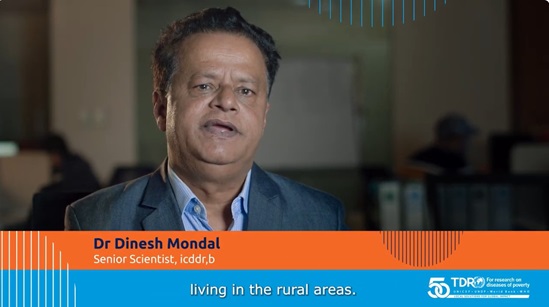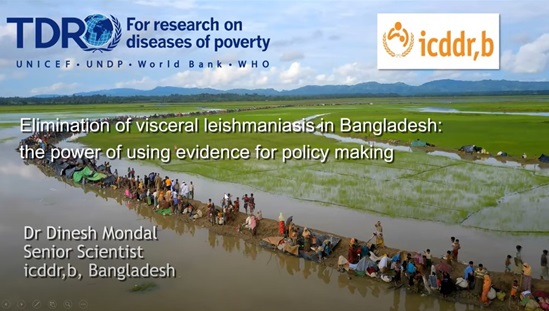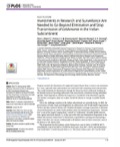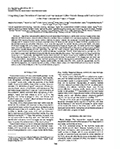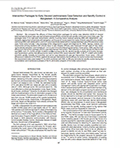.tmb-768v.jpg?Culture=en&sfvrsn=70565d8f_1)
Visceral leishmaniasis research
The global burden of visceral leishmaniasis (VL), commonly
known as kala-azar, has dropped dramatically in recent years due to gains made
through a regional visceral leishmaniasis elimination programme launched in
2005 in Nepal, Bangladesh and India.
TDR has been working with research institutions and control programmes in the Indian subcontinent and supporting studies that inform policy and practice to achieve the elimination target of below one case of VL per 10,000 inhabitants.
Visceral leishmaniasis in the Indian subcontinent
Support to the visceral leishmaniasis (VL) elimination effort in
the Indian subcontinent has been one of the longest and most successful
implementation research programmes at TDR. In 2023, Bangladesh became the first country in the world to be
officially validated for having eliminated
visceral leishmaniasis as a public health problem. However, further
investments and new approaches are required to ensure elimination is sustained.
Resurgence of the disease could mean loss of all gains and waste of all efforts
made so far to control the spread of the disease.
Current work focuses on consolidating and maintaining progress.
These include investigations on strategies to improve active case detection,
optimal vector control and surveillance strategies, and integrated
interventions. Some of the TDR-supported work in progress includes
investigation into new VL cases reported from previously non-endemic sites,
treatment follow-up to determine reasons for relapse, including the impact of
COVID-19 on VL services, and studies on the prevalence of post-kala-azar dermal
leishmaniasis (PKDL) as a potential source for new cases and emergence of new
foci.
Determination of Prevalence of Post-Kala-azar Dermal Leishmaniasis (PKDL) and Assessment of Treatment Seeking Behaviour of PKDL Patients in Nepal and Bangladesh
The true burden of PKDL is not known in Bangladesh and Nepal. There is no routine active case detection of post-kala-azar dermal leishmaniasis (PKDL) by the national programmes. Since both nodular and macular PKDL patients are infectious to sandflies, PKDL could be a challenge for sustaining VL elimination in the Indian subcontinent. Studies have just been completed in both Nepal and Bangladesh to determine the prevalence of PKDL in selected areas and at the same time identify risk factors and the health care-seeking behavior of PKDL patients in these countries. House-to-house surveys were conducted for PKDL in villages of selected districts or upazilas that have reported the highest number of VL cases within the last four years. Suspected PKDL cases positive for rK39 rapid test were referred to a nearby hospital for further confirmation and treatment according to national guidelines. To increase the detection efficiency of PKDL, an integrated diagnostic approach was implemented in leprosy hospitals where patients with skin lesions negative for leprosy were evaluated for PKDL.
Preliminary analysis of data indicates that the prevalence of PKDL is 2.23/10,000 population in Nepal and 36/10,000 in Bangladesh. Most of the PKDL cases (54/59) in Bangladesh had a past history of VL whereas only 5/9 had previous VL in Nepal. A large proportion of the PKDL cases lacked knowledge of VL and suffered stigma in both countries. The findings demonstrate that PKDL detection and case management should be strengthened within the kala azar elimination programme.
Follow-up Assessment of Visceral Leishmaniasis (VL) Treated Patients and Assessment of Impact of COVID-19 in VL Control Services in Nepal and Bangladesh
The follow-up assessment of treated visceral leishmaniasis (VL) cases is important to monitor the effectiveness of treatment regimens. Although follow-up of treated VL cases is integrated into the national strategy of VL elimination, compliance appears to be limited. In addition, the COVID-19 pandemic has negatively impacted provision of and access to health care services. This could have long-term effects on the VL elimination programmes in countries.
TDR-supported studies have recently been investigating the barriers to effective follow-up of treated VL cases. The studies monitored treatment outcome and assessed the impact of COVID-19 on VL control services and activities. Health workers and patients were interviewed to identify gaps in strategy and to assess the impact of COVID-19 on VL services and the elimination programme. VL cases treated within the last two years were monitored for clinical improvement, relapse or other consequences of treatment.
Findings indicated that a significant proportion of patients who had completed treatment developed relapse or PKDL on further follow up. Relapse was more frequent than PKDL and a few had both relapse and PKDL.
The impact of the COVID-19 pandemic varied across health facilities in Bangladesh with no added delay to diagnosis but an almost two-fold delay in treatment initiation and reporting time. In Nepal, almost all newly diagnosed cases were put on treatment within a week of diagnosis. Only 10% had to cancel their appointments due to COVIID-19. Insecticide spraying was significantly hampered in both countries due to supply shortages. The studies are generating evidence relevant to certification of the elimination of VL in both countries and contribute to strategies for better management of VL in emergency situations so that the progress in VL elimination is sustained.
Epidemiological, Serological and Entomological Investigation of New Visceral Leishmaniasis (VL) Foci in Nepal and Bangladesh
Emergence of new foci of transmission in previously non-endemic sites is a threat to the VL elimination effort. It is critical to verify cases, determine the magnitude, identify the main driving forces and suppress transmission as early as possible.
Studies were conducted in Nepal and Bangladesh to explore epidemiological, serological and entomological aspects of visceral leishmaniasis in suspected new VL foci. The studies determined the endemicity status and described epidemiological and clinical characteristics, including prevalence of asymptomatic infection of VL in the suspected new VL foci. Local transmission was verified through case investigation and travel history. Vector surveys were conducted to assess sand fly density and distribution and infection rates, and to determine spatial relationship with VL infection along with assessment of environmental conditions conducive for vector breeding and transmission of VL. The effectiveness of community awareness training sessions was measured through surveys.
Preliminary results indicate that many of the foci reporting VL for the first time in both Nepal and Bangladesh are actually endemic sites that require programmatic intervention as per national guidelines. Good quality reporting in the DHIS2 platform is essential for monitoring. Community awareness campaigns are effective in improving knowledge of VL and exercise of preventive measures. The findings will contribute to the evidence base to inform an integrated package of strategic interventions which are critical for a post-elimination phase in both Nepal and Bangladesh.
Prevalence of VL-HIV co-infection in Bangladesh
Bangladesh is a low endemic country for Human immunodeficiency virus (HIV) infection with less than 0.01% prevalence in the general population. However, there remains a major gap of knowledge on the VL-HIV co-infection status in Bangladesh with no such study reported so far. Sentinel surveillance for HIV-VL coinfection is a pre-requisite before applying for validation of VL elimination. In a TDR-supported study, participants from previous VL investigations were contacted and those who were willing were invited to visit a VL center for informed consent, counselling and HIV testing. So far, over 250 patients have been tested and none were found positive for HIV. The prevalence of HIV-VL co-infection in Bangladesh appears to be very low.
Decision-Making for Indoor Residual Spraying in Post-Elimination Phase of Visceral Leishmaniasis In Bangladesh and Nepal
Indoor residual spraying is a key tool for vector control in VL elimination. Twice yearly application is recommended in villages reporting VL cases. However, IRS is labor intensive and requires specialist experience. To be effective, it needs timely application with proper planning, adequate resources, and logistic support. The effectiveness of IRS depends on several factors that may change over time. Susceptibility of sandflies to the insecticides in use needs to be regularly monitored. The real contribution of vector control with IRS in the elimination of VL is still unclear. There is a lack of systematic assessment of IRS including of vector and VL transmission parameters in humans to provide recommendations in different transmission scenarios.
Two studies in Nepal and Bangladesh are investigating the relationship between the occurrence of VL and the frequency of IRS applied on VL vector density, infection rate and insecticide resistance in low endemic, high-endemic and non-endemic villages. Epidemiological and programmatic data of the last 10 years will be analyzed along with relevant ecological parameters to identify critical determinants that can inform rational decision making on the application of IRS in the last mile of VL elimination.
Microstratification of VL risk in Bangladesh and Nepal
As VL elimination progresses, it becomes increasingly important to monitor heterogeneity in the distribution and transmission of VL at smaller geographical units to identify high risk areas within a district, village or community. Microstratification enables a localized understanding of the epidemiology of VL for a more effective intervention.
Two pilot studies are currently underway on microstratification of VL in Bangladesh and Nepal addressing disease burden, receptivity (ecology) and vulnerability. The stratification will be into high, moderate, low and no risk and will be done at the village level in both countries using secondary data from the last 10 years.
Distilling lessons from the VL elimination efforts in the Indian subcontinent for other regional foci
The impact of TDR-supported implementation research on VL elimination in Bangladesh and Nepal was assessed from the perspective of the countries. Two reports highlighted key research contributions that led to impacts in diagnosis (rK39 was validated and used as a confirmatory test for VL); treatment (miltefosine replaced sodium stibogluconate as a first line of treatment; liposomal amphotericin B replaced miltefosine subsequently due to increased treatment failures and relapse rates; combination therapy was introduced into the national protocol of treatment); Surveillance (active case detection was incorporated into the national protocol of VL elimination); and Vector control (integrated vector management was recognized as an important element in the elimination efforts). The close partnership between implementation research (supported by TDR and others) and programmes in the research-practice-research cycle over several years for evidence-informed decisions was a significant factor in the success of the VL elimination programmes of both countries. Key lessons included that IR is most effective when responsive, sustained and country-owned.
Visceral leishmaniasis in Eastern Africa
Eastern Africa is currently the largest regional focus accounting for 57% of all new cases globally in 2020. The proportion of reported cases from Eastern Africa increased from 10% to more than 50% of the global total in the last 15 years, with a threefold increase in actual numbers in 2018 compared to 2007. The focus is known for repeated outbreaks.
VL endemic countries in Eastern Africa have requested for WHO support to address the growing problem of VL in the region. TDR is collaborating with WHO to support the launch of a VL elimination programme in Eastern Africa with lessons drawn from the successful experience of the Kala-Azar Elimination Programme in the Indian subcontinent.
Although the epidemiology of VL in the region poses more challenges for elimination than in South-East Asia, a recent WHO-convened key stakeholders meeting in Nairobi in January 2023 (with high-level representatives from countries, global and African
partners, the African Union Commission and delegates from WHO/HQ, AFRO, EMRO and six WHO country offices) concluded that elimination of VL from the eastern African focus is both feasible and timely. A Call for Action (the “Nairobi Declaration”)
was issued, and a draft Strategic Plan has been developed.
In support of the regional VL elimination plan, TDR and WHO recently issued a joint call for applications on assessing programme capacities in VL-endemic countries in East Africa to implement WHO’s treatment recommendations towards achieving universal health coverage and NTD roadmap targets. A team of investigators at the University of Gondar, Ethiopia, will lead the review of programme status in Eritrea, South Sudan and Sudan to identify areas for strengthening in the launch of elimination efforts.
In addition, TDR is working with WHO on preparations for the comparative evaluation of the performance of point of care rk39 rapid tests in the diagnosis of VL in the Eastern African region.
News
Videos
Publications



